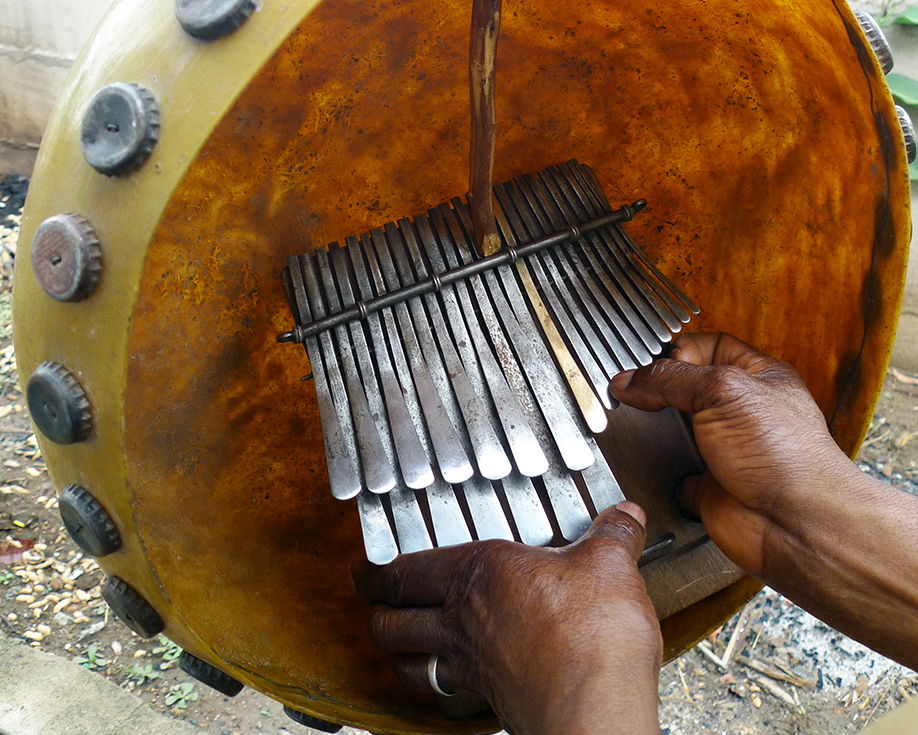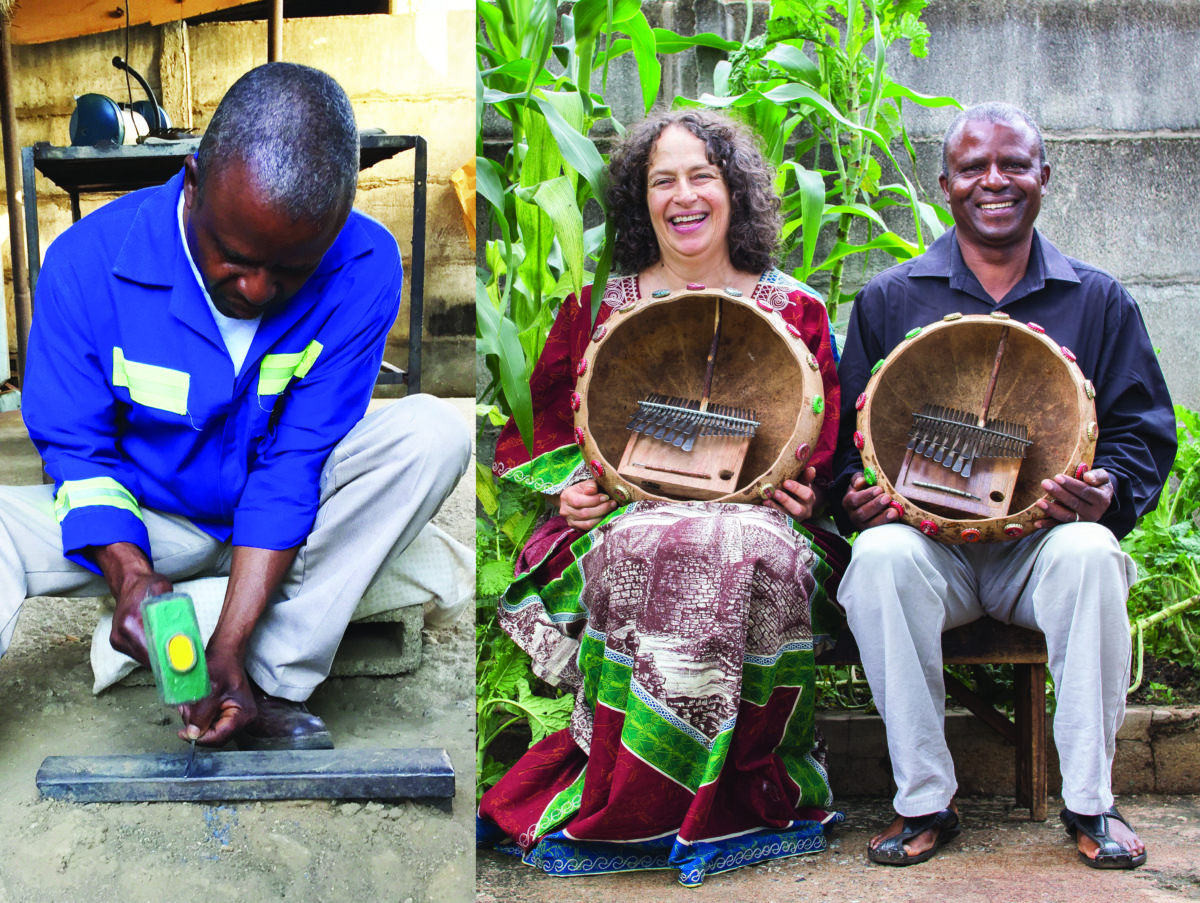When Erica Azim and Fradreck Mujuru first met, in 1991, Mujuru was waiting tables in the Zimbabwean capital city of Harare and working as an instrument maker on the side. Azim was visiting the country as a student of that instrument: the mbira, a type of African lamellaphone, or thumb piano. Over the years, the two forged a deep musical friendship, one rooted in the intimate interplay of the mbira’s lilting polyrhythms.
These days, Mujuru makes mbiras full-time and is widely regarded as one of the greatest mbira players alive, while Azim is a respected teacher and scholar of the instrument in the U.S. On October 30, 2017 they will perform together at Killian Hall in Cambridge as part of MIT’s Sounding concert series.
Azim first picked up the mbira back in the ‘70s, when she was an undergrad at the University of Washington, the first place where the instrument was seriously taught in the U.S. She was instantly smitten. “[Mbira music] touches me at every level,” Azim says. “The level of your soul, your heart, your body, your mind. Everything.”
Mujuru and Azim play a style of mbira traditional to the Shona people of Zimbabwe. The Shona mbira features two rows of keys, often made of salvaged metal, mounted inside an enormous, round gourd that acts as a resonator. Shells or bottle caps affixed to the instrument buzz gently in time to the player’s cross-rhythmic pluckings. The keys produce bell-like tones that ping-pong off of one another in intricate counter-melody. The tunes are cyclical, meaning they have no definitive beginning or end point, their whirling perambulations at once propulsive and serene.
“Mbira music is played for all kinds of things, but the most important thing it’s played for are ceremonies that go all night long to call an ancestor spirit,” Azim says. “People are dancing, clapping, singing along. … When you play mbira in that context, it’s not like you’re a performer at all.”
“The Shona people have always had these communications with the ancestors, from time immemorial,” Mujuru says. “The instrument is used as medium so that when we talk to [the ancestors], we get guidance from them.”
In the ‘70s, guitar licks inspired by mbira patterns became the bedrock of chimurenga music, the popular soundtrack to the Zimbabwe War of Liberation. And the instrument continues to find its way into pop music today. “There’s all kinds of young people that are trying any old thing and playing any which music on their mbiras,” Azim says. “When I went the first time, some people were playing reggae on their mbira, and now you can find someone playing hip-hop on their mbira.”
For many Zimbabweans, the mbira provides a link to a traditional culture that was almost wiped out during nearly a century of British colonial rule. “During the time when colonialism came into Zimbabwe, the whites came and tried to discourage the Shona people [from practicing] their Shona culture, and their traditions,” Mujuru says. But, he explains, because the mbira has always been “part of the Shona people,” the instrument and its music survived. Even now, there are people who think the music may die out. “But we don’t think it’s going to die,” he says. “Because it is us.”
Mbira come in many different tunings, and most players only master one. But Mujuru is one of the instrument’s most versatile practitioners, and his instrument-making practice has helped him become deeply acquainted with multiple tunings. “He’ll be making some new tuning and then he’ll really get into it and he’ll be playing it every night and … really find amazing ways to play in that particular tuning,” Azim says. “So I think that has given him a particular breadth, in Zimbabwe, as a musician, that is unique.”
MIT students will have the rare chance to learn how to build mbira during Mujuru’s residency at the university. “MIT students like to make things,” says Patricia Tang, an associate professor of music at MIT who invited Mujuru to take part in her Making African Instruments Project. She hopes that his instrument-making workshops will help the students gain a deeper understanding of the mbira and its music. “It’s a very limited number of artisans who have this skill, and it’s not something that’s usually shared with the rest of the world,” Tang says. “By helping to make these instruments, [students] also are going to learn so much about the culture they come from.”
For Azim’s part, nothing beats jamming with another mbira player, especially one as good as Mujuru. “That’s the best,” she says. Together, they embark on extraordinary flights of interlocking improvisation. Jazz players probably won’t recognize this style of improv, Azim says, which is less an expression of individual creativity as a melodic tapestry woven in tight tandem.
“You’re just in the moment together, and you’re really improvising on the one thing that the two of you have created together,” Azim says. “You don’t listen to my part and his part. You listen to the whole thing.” In these mesmerizing moments it is sometimes possible to detect the ephemeral whisperings of a long-forgotten history, summoned into being with the flick of a thumb, inviting its descendants to dance.
MIT Sounding presents: Fradreck Mujuru and Erica Azim
October 30, 2016: 3:00 pm pre-concert talk, 4:00 pm concert
MIT Killian Hall, 14-W111, 160 Memorial Drive, Cambridge
MIT Sounding is sponsored by the MIT Center for Art, Science & Technology and MIT Music and Theater Arts




